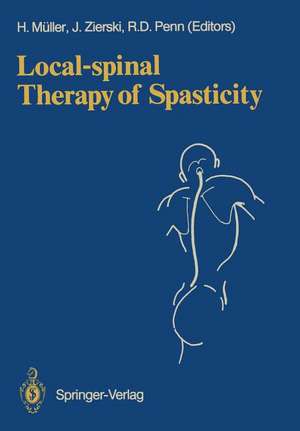Local-spinal Therapy of Spasticity
Editat de Hermann Müller, Jan Zierski, Richard D. Pennen Limba Engleză Paperback – 15 apr 1988
Preț: 717.00 lei
Preț vechi: 754.74 lei
-5% Nou
Puncte Express: 1076
Preț estimativ în valută:
137.20€ • 142.96$ • 113.60£
137.20€ • 142.96$ • 113.60£
Carte tipărită la comandă
Livrare economică 03-17 aprilie
Preluare comenzi: 021 569.72.76
Specificații
ISBN-13: 9783540182955
ISBN-10: 3540182950
Pagini: 280
Ilustrații: VIII, 270 p. 94 illus.
Dimensiuni: 170 x 244 x 15 mm
Greutate: 0.45 kg
Editura: Springer Berlin, Heidelberg
Colecția Springer
Locul publicării:Berlin, Heidelberg, Germany
ISBN-10: 3540182950
Pagini: 280
Ilustrații: VIII, 270 p. 94 illus.
Dimensiuni: 170 x 244 x 15 mm
Greutate: 0.45 kg
Editura: Springer Berlin, Heidelberg
Colecția Springer
Locul publicării:Berlin, Heidelberg, Germany
Public țintă
ResearchCuprins
Preface.- Preface.- A Short Historical Review of Spasticity and Its Therapy.- A Short Historical Review of Spasticity and Its Therapy.- Basic Experiences.- Spinal Pharmacology of Agents which Alter Pain Transmission and Muscle Tone.- The Neuropharmacology of Baclofen.- Animal Experiments on the Spinal Action of Midazolam.- Intrathecal Injection of Antispastic Drugs in Rats: Muscle Relaxant Action of Midazolam, Baclofen, 2-Aminophosphonoheptanoic Acid (AP7) and Tizanidine.- CSF Compatibility of Antispastic Agents.- Dural Permeability to Bupivacaine, Baclofen and Midazolam: In Vitro Determination with Human Dura Mater.- Clinical Studies.- Pharmacotherapy of Spasticity.- Pumps in Pharmacotherapy.- Implantation of Ports and Pumps. Technique for Intrathecal Administration of Drugs.- Control of Spasticity with Intrathecal Morphine Sulfate.- Clinical Experience with Spinal Morphine, Midazolam and Tizanidine in Spasticity.- Chronic Intrathecal Baclofen for Severe Rigidity and Spasms.- Intrathecal Baclofen in Spasticity.- Chronic Intrathecal Administration of Baclofen in Treatment of Severe Spasticity.- Pharmacokinetics of Intrathecal Baclofen.- Intrathecal Baclofen in tetanus.- The Value of Spinal Cord Stimulation (SCS) in Treatment of Disorders of the Motor System.- Physostigmine Reversal of Baclofen-induced Sedation.- Surgical Treatment of Spasticity- A Review.














